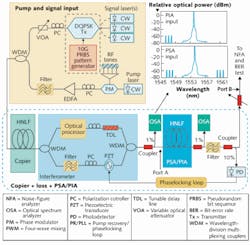OPTICAL AMPLIFIERS: Phase-sensitive fiber-optic amplifier has record-low 1.1 dB noise

Commercial optical fiber amplifiers such as erbium-doped fiber amplifiers (EDFAs) are phase-insensitive with a well-known 3 dB quantum-limited noise figure. Although phase-sensitive amplifiers (PSAs) can theoretically have zero additional noise, their implementation is more complex and often not applicable to broadband transmission links, limiting their commercial allure. But a team of researchers from Chalmers University of Technology (Göteborg, Sweden), Alcatel-Lucent (Holmdel, NJ), the University of California–San Diego (La Jolla, CA), the National Institute of Information and Communications Technology (Tokyo, Japan), Doshisha University (Kyoto, Japan), and OFS (Brøndby, Denmark) have developed a “copier” PSA scheme that is up to 6 dB better than any commercial phase-insensitive amplifier (PIA) and 3 dB better than alternative (or “conventional”) PSA link architectures.1
Basically, PSA links are of two varieties that are based on the nonlinear phenomenon called parametric effect: frequency-degenerate amplifiers in which the signal and idler frequencies are identical, and nondegenerate amplifiers in which the signal and idler frequencies are different. The signal is the transmission beam that needs to be amplified, while the idler is the beam automatically generated through the parametric effect but perfectly coherent with the signal. Unfortunately, degenerate PSAs suffer from low gain and only amplify one wavelength—a serious drawback in broadband or wavelength-division-multiplexing (WDM) transmission schemes. For nondegenerate setups, it is difficult to phaselock two or more independent laser inputs; however, this difficulty can be overcome through parametric idler creation in which a conventional parametric PIA (copier) is followed by one or more nondegenerate PSAs.
The ‘copier’ scheme
To produce ultralow-noise-floor amplification without affecting the wavelength characteristics of an arbitrary broadband signal, a conventional PIA EDFA-based amplifier setup with a multilaser signal and a pump-laser signal are combined in a WDM coupler (see figure). This signal is then input to a length of highly nonlinear fiber that acts as a copier—mimicking the capabilities of a conventional PIA link but inducing a highly correlated and frequency-separated idler. The name “copier” is based on the fact that the nondegenerate parametric effect will duplicate the signal (with conjugated phase) at a different wavelength.
A liquid-crystal-on-silicon (LCOS) optical processor is used to independently adjust the power and phase of the signal and idler beams; that is, the system can be switched from PSA to PIA by turning off the copier-generated idler beam.
Using the PSA setup, noise floor was measured at 1.1 ± 0.4 dB at a 26.5 dB gain with -42 dBm signal input power—the lowest noise figure ever measured for any optical amplifier with reasonably high (greater than 10 dB) gain, according to the researchers. The excess noise, resulting in a noise figure larger than 0 dB, is due to spontaneous Raman scattering from thermal phonons and distributed loss in the PSA’s highly nonlinear optical fiber, with measurement bandwidth limited by the optical processor. Bit-error-rate (BER) performance testing clearly showed a significant signal-to-noise ratio advantage (about 5.5 dB) of copier-PSA-based systems over conventional EDFA-based links and the capability to amplify multichannel and multilevel signals.
“This is the first time that noiseless amplification—which has long been known as an impractical quantum concept—has been observed in such a practical manner,” says Zhi Tong, postdoctoral researcher at Chalmers University of Technology. “This is a unique and exciting topic, but there are still many technical difficulties that need to be addressed to make this nonclassical amplifier compatible with real-world applications.”
REFERENCE
1. Z. Tong et al., Nature Photon. online (June 5, 2011); doi:10.1038/NPHOTON.2011.79.

Gail Overton | Senior Editor (2004-2020)
Gail has more than 30 years of engineering, marketing, product management, and editorial experience in the photonics and optical communications industry. Before joining the staff at Laser Focus World in 2004, she held many product management and product marketing roles in the fiber-optics industry, most notably at Hughes (El Segundo, CA), GTE Labs (Waltham, MA), Corning (Corning, NY), Photon Kinetics (Beaverton, OR), and Newport Corporation (Irvine, CA). During her marketing career, Gail published articles in WDM Solutions and Sensors magazine and traveled internationally to conduct product and sales training. Gail received her BS degree in physics, with an emphasis in optics, from San Diego State University in San Diego, CA in May 1986.